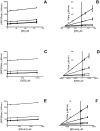Inhibitory potency of 4-carbon alkanes and alkenes toward CYP2E1 activity
- PMID: 24561005
- PMCID: PMC4747242
- DOI: 10.1016/j.tox.2014.02.003
Inhibitory potency of 4-carbon alkanes and alkenes toward CYP2E1 activity
Abstract
CYP2E1 has been implicated in the bioactivation of many small molecules into reactive metabolites which form adducts with proteins and DNA, and thus a better understanding of the molecular determinants of its selectivity are critical for accurate toxicological predictions. In this study, we determined the potency of inhibition of human CYP2E1 for various 4-carbon alkanes, alkenes and alcohols. In addition, known CYP2E1 substrates and inhibitors including 4-methylpyrazole, aniline, and dimethylnitrosamine were included to determine their relative potencies. Of the 1,3-butadiene-derived metabolites studied, 3,4-epoxy-1-butene was the strongest inhibitor with an IC50 of 110 μM compared to 1700 μM and 6600 μM for 1,2-butenediol and 1,2:3,4-diepoxybutane, respectively. Compared to known inhibitors, inhibitory potency of 3,4-epoxy-1-butene is between 4-methylpyrazole (IC50 = 1.8 μM) and dimethylnitrosamine (IC50 = 230 μM). All three butadiene metabolites inhibit CYP2E1 activity through a simple competitive mechanism. Among the 4-carbon compounds studied, the presence and location of polar groups seems to influence inhibitory potency. To further examine this notion, the investigation was extended to include structurally and chemically similar analogues, including propylene oxide and various butane alcohols. Those results demonstrated preferential recognition of CYP2E1 toward the type and location of polar and hydrophobic structural elements. Taken together, CYP2E1 metabolism may be modified in vivo by exposure to 4-carbon compounds, such as drugs, and nutritional constituents, a finding that highlights the complexity of exposure to mixtures.
Keywords: Butadiene; CYP2E1; Cytochrome P450; Epoxide.
Published by Elsevier Ireland Ltd.
Figures





Similar articles
-
Differences in butadiene adduct formation between rats and mice not due to selective inhibition of CYP2E1 by butadiene metabolites.Toxicol Lett. 2013 Nov 25;223(2):221-7. doi: 10.1016/j.toxlet.2013.08.025. Epub 2013 Sep 8. Toxicol Lett. 2013. PMID: 24021170 Free PMC article.
-
The biotransformation of isoprene and the two isoprene monoepoxides by human cytochrome P450 enzymes, compared to mouse and rat liver microsomes.Chem Biol Interact. 1996 Dec 20;102(3):169-82. doi: 10.1016/s0009-2797(96)03741-6. Chem Biol Interact. 1996. PMID: 9021169
-
Oxidation of 1,2-epoxy-3-butene to 1,2:3,4-diepoxybutane by cDNA-expressed human cytochromes P450 2E1 and 3A4 and human, mouse and rat liver microsomes.Carcinogenesis. 1995 Oct;16(10):2287-93. doi: 10.1093/carcin/16.10.2287. Carcinogenesis. 1995. PMID: 7586124
-
A review of the genetic and related effects of 1,3-butadiene in rodents and humans.Mutat Res. 2000 Oct;463(3):181-213. doi: 10.1016/s1383-5742(00)00056-9. Mutat Res. 2000. PMID: 11018742 Review.
-
The cytochrome P-450 isoenzyme CYP2E1 in the biological processing of industrial chemicals: consequences for occupational and environmental medicine.Int Arch Occup Environ Health. 2003 Apr;76(3):174-85. doi: 10.1007/s00420-002-0407-4. Epub 2003 Mar 1. Int Arch Occup Environ Health. 2003. PMID: 12690492 Review.
Cited by
-
Cooperativity in CYP2E1 metabolism of acetaminophen and styrene mixtures.Biochem Pharmacol. 2015 Oct 1;97(3):341-9. doi: 10.1016/j.bcp.2015.07.026. Epub 2015 Jul 28. Biochem Pharmacol. 2015. PMID: 26225832 Free PMC article.
-
Crystal Structure of a Putative Cytochrome P450 Alkane Hydroxylase (CYP153D17) from Sphingomonas sp. PAMC 26605 and Its Conformational Substrate Binding.Int J Mol Sci. 2016 Dec 9;17(12):2067. doi: 10.3390/ijms17122067. Int J Mol Sci. 2016. PMID: 27941697 Free PMC article.
-
1,3-Butadiene-induced mitochondrial dysfunction is correlated with mitochondrial CYP2E1 activity in Collaborative Cross mice.Toxicology. 2017 Mar 1;378:114-124. doi: 10.1016/j.tox.2017.01.005. Epub 2017 Jan 9. Toxicology. 2017. PMID: 28082109 Free PMC article.
-
Subcellular localization of rat CYP2E1 impacts metabolic efficiency toward common substrates.Toxicology. 2015 Dec 2;338:47-58. doi: 10.1016/j.tox.2015.10.001. Epub 2015 Oct 14. Toxicology. 2015. PMID: 26463279 Free PMC article.
-
The methylimidazolium ionic liquid M8OI is detectable in human sera and is subject to biliary excretion in perfused human liver.Toxicology. 2021 Jul;459:152854. doi: 10.1016/j.tox.2021.152854. Epub 2021 Jul 13. Toxicology. 2021. PMID: 34271081 Free PMC article.
References
-
- Albertini RJ, Sram RJ, Vacek PM, Lynch J, Nicklas JA, van Sittert NJ, Boogaard PJ, Henderson RF, Swenberg JA, Tates AD, Ward JB, Jr, Wright M, Ammenheuser MM, Binkova B, Blackwell W, de Zwart FA, Krako D, Krone J, Megens H, Musilova P, Rajska G, Ranasinghe A, Rosenblatt JI, Rossner P, Rubes J, Sullivan L, Upton P, Zwinderman AH. Biomarkers in Czech workers exposed to 1,3-butadiene: a transitional epidemiologic study. HEI Report. 2003;116:1–141. - PubMed
-
- Bechtold WE, Strunk MR, Chang IY, Ward JB, Henderson RF. Species-Differences in Urinary Butadiene Metabolites - Comparisons of Metabolite Ratios Between Mice, Rats, and Humans. Toxicol Appl Pharmacol. 1994;127:44–49. - PubMed
-
- Chauret N, Gauthier A, Nicoll-Griffith DA. Effect of common organic solvents on in vitro cytochrome P450-mediated metabolic activities in human liver microsomes. Drug Metab Dispos. 1998;26:1–4. - PubMed
Publication types
MeSH terms
Substances
Grants and funding
LinkOut - more resources
Full Text Sources
Other Literature Sources

